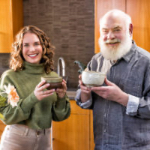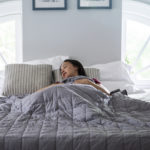10 Must-Know Sleep Terms

Getting a good night’s sleep is about much more than going to bed at a decent time. Familiarizing yourself with some of the more common sleep and bedding terms is a great way to identify your habits that influence the quality of your sleep.
About Sleep
REM Sleep
Rapid Eye Movement (REM) sleep is an important phase of sleep. It’s the fourth stage, in which most of your dreams occur, following three previous stages of non-REM sleep (NREM). This vital stage is necessary for optimal performance, both mental and physical. Learn more about REM sleep on our blog post, “How Do You Improve REM Sleep?”
Sleep Posture
Your sleep posture is the position your body is in while you sleep. This impacts both your breathing while you sleep as well as how your body is aligned. A good way to ensure you have the best sleep posture is to use a comfortable, supportive pillow.
Sleep Hygiene
Sleep hygiene is the set of habits and behaviors that help create a better sleep experience and environment. Components of sleep hygiene include keeping your bedroom dark, quiet, and at an ideal temperature, as well as maintaining a consistent sleep schedule.
Sleep Maintenance
Your sleep maintenance is your ability to stay asleep throughout the night after you’ve initially fallen asleep. Identifying and correcting some of the common reasons you find yourself waking up, such as noise, light, discomfort, or temperature, can help improve your sleep maintenance. Because temperature is a common reason for waking up throughout the night, using thermoregulating bedding is a good place to start.
About Bedding
Mattress Protector
A mattress protector is a removable cover that is placed on top of your mattress. Unlike a mattress pad, which is designed to change the comfort of your mattress, the protector’s main purpose is to create a barrier against dust mites, moisture, allergens, and more for cleaner, better sleep.
Coverlet
A coverlet is a layer of bedding that adds comfort, warmth, and style. Coverlets are made from a single piece of fabric that is designed with a sewing technique known as matelassé. Unlike quilts, which utilize multiple layers of fabric, the single piece of fabric used for a coverlet offers lighter, more breathable coverage for layering.
Natural Fibers
Examples of natural fibers are cotton, hemp, linen, and wool. These provide benefits such as hypoallergenic and thermoregulating properties. Learn more from: “Your Guide to Creating a Natural Sleep Space.”
Thread Count
Thread count is a unit of measurement that identifies the number of threads in a square inch of fabric. A fabric’s thread count is found by combining the number of horizontal (weft) threads and vertical (warp) threads. While many people think thread count is important when looking for new bedding, the quality of the fibers used is of higher importance, impacting both the comfort and durability of the fabric.
Merino Wool
Sourced from Merino sheep in Australia, this type of wool offers the softness and support you love from traditional wool with added sleep benefits that come from its finer texture. It has naturally thermoregulating and moisture-wicking properties while also providing a more hypoallergenic, breathable sleep surface.
Garment Washed
The term “garment washed” is not the fibers or weave used to create a fabric, but rather the way the fabric is treated before you use it. If a fabric is garment washed, that simply means it has been prewashed in a special way that helps create a soft, lived-in feel straight out of the package.
Today’s Health Topics
Editor's Pick
Health Focus
Ask Dr. Weil's Q&A
| Join Dr. Weil On Instagram! |
| See the latest pictures and videos of Dr. Weil’s daily life, gardening adventures and wellness journey. Share in his love of traveling, cooking, gardening and meeting new people. Follow along on Instagram today! You can also find him on Facebook and Twitter. |
|










